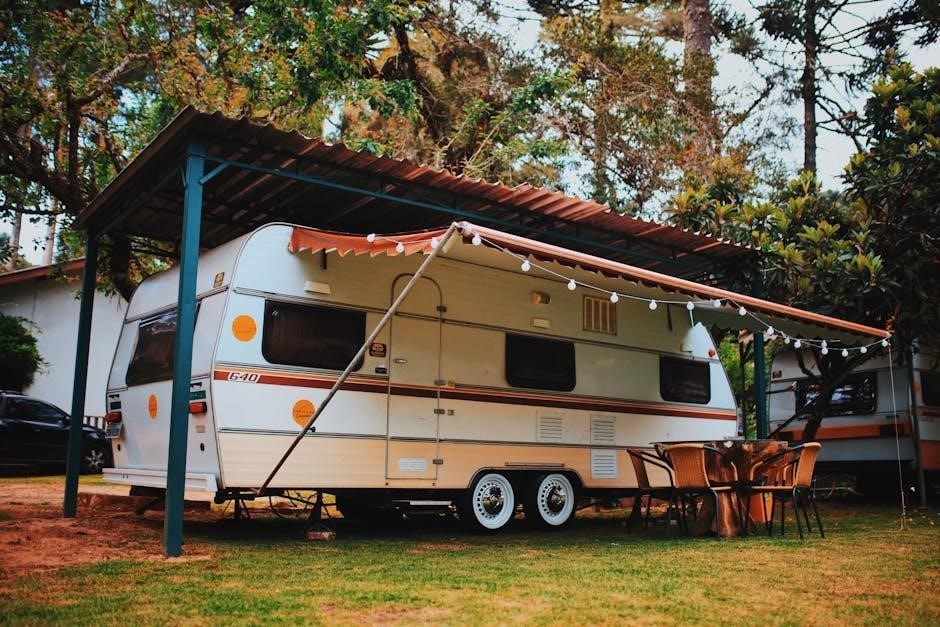Manual Awning for Camper: A Comprehensive Guide
Embark on a journey to enhance your camping experience with manual RV awnings. This comprehensive guide will navigate you through understanding, selecting, and maintaining the ideal awning for your camper. Discover how a manual awning offers shade, protection, and an inviting outdoor space.
Welcome to the world of manual RV awnings, a realm where simplicity meets functionality for the avid camper. Manual awnings represent a traditional approach to creating a comfortable outdoor living space adjacent to your recreational vehicle. Unlike their electric counterparts, these awnings rely on human power for extension and retraction, offering a straightforward and dependable solution.
These awnings typically feature a roll-out design, easily unfurled to provide shade and shelter from the elements. Characterized by their ease of use and affordability, manual awnings are a popular choice for RV enthusiasts seeking a cost-effective and reliable addition to their setup. They are often crafted from durable materials like vinyl or acrylic, designed to withstand the rigors of outdoor use.
Manual RV awnings offer a tangible connection to the camping experience. Operating the awning becomes part of the ritual of setting up camp, fostering a sense of self-reliance and appreciation for the simplicity of the outdoors. This introduction explores the benefits, types, and essential features of manual RV awnings.
Types of Manual RV Awnings
Within the category of manual RV awnings, there exists a variety of types, each designed to cater to specific needs and preferences. The classic roll-out awning is perhaps the most common, featuring a fabric canopy that extends from the side of the RV with the assistance of support arms. These arms can be affixed to the ground or the RV itself, providing stability.
Another type includes window awnings, typically smaller and designed to provide shade and protection for individual windows. These can be manually adjusted to control the amount of sunlight entering the RV.
While less common, fixed awnings represent a more permanent shelter solution. Though they don’t retract, they offer robust protection from the elements. Winch awnings utilize an internal winch system for easier operation, simplifying the extension and retraction process.
Understanding the different types of manual RV awnings is essential for selecting the best option. Each type offers distinct advantages, whether it’s the simplicity of a roll-out awning, the targeted shade of a window awning, or the robust protection of a fixed awning.
Benefits of Choosing a Manual Awning
Opting for a manual RV awning presents a range of benefits. Foremost is the cost-effectiveness. Manual awnings generally have a lower price point compared to their electric counterparts, making them an attractive option for budget-conscious RVers. This affordability extends beyond the initial purchase, as manual awnings typically require less maintenance and repair, further reducing long-term expenses.
The simplicity of design contributes to their reliability. With fewer moving parts, there’s less that can go wrong, minimizing the risk of mechanical failures. The absence of an electric motor eliminates the worry of motor burnout or electrical issues, ensuring that your awning will function reliably.
Manual awnings offer a sense of self-reliance and control. You have direct command over the awning’s extension and retraction, allowing for precise adjustments based on weather conditions and personal preference. This manual operation fosters a deeper connection with your RV and the surrounding environment.

Manual awnings can be a great DIY project for people who want to improve the looks of their RV, fifth-wheel camper trailer, or camper van while on a budget.
Manual vs. Electric Awnings: A Comparison
When selecting an RV awning, a key decision involves choosing between manual and electric operation. Manual awnings require physical effort to extend and retract, typically using a hand crank or pull strap. This simplicity translates to lower initial cost and reduced maintenance, as there are fewer components that can fail. However, manual operation can be cumbersome, especially for larger awnings or individuals with mobility limitations.
Electric awnings offer the convenience of push-button operation. An integrated motor handles the extension and retraction, saving time and effort. Some electric awnings even include features like automatic wind detection, which retracts the awning in high winds to prevent damage. However, this convenience comes at a higher price point, both in terms of initial cost and potential maintenance.
Electric awnings rely on a power source, which could be a concern in off-grid situations. Additionally, the complexity of an electric system increases the likelihood of mechanical or electrical issues. Ultimately, the choice between manual and electric awnings depends on individual needs and priorities.
Consider your budget, physical capabilities, and desired level of convenience when making your decision.
Essential Features of Manual RV Awnings

When choosing a manual RV awning, several key features contribute to its functionality and durability. A robust and easy-to-use manual mechanism is essential for smooth extension and retraction. Look for features like a crank handle or a simple pull strap system for effortless operation. The awning’s fabric should be durable and weather-resistant, capable of withstanding sun, rain, and wind.
Consider materials like specialized PVC or heavy-duty vinyl, which offer UV protection, water resistance, and resistance to mold and mildew. Sturdy support arms and rafter knobs are crucial for stability, especially in windy conditions. Some awnings also offer adjustable height settings, allowing you to customize the shade and coverage.
Additionally, look for features like rain dump, which automatically drains water to prevent pooling on the awning. Integrated Weatherguards protect your RV Awning from the sun and the elements while you are on the road. Check for compatibility with accessories like screen rooms or LED lighting to enhance your outdoor living space.
Prioritizing these essential features will ensure that your manual RV awning provides reliable performance and lasting enjoyment.
Materials Used in Manual RV Awnings
The durability and longevity of a manual RV awning heavily rely on the materials used in its construction. The awning fabric is a primary consideration, with options like acrylic and vinyl being popular choices. Acrylic awnings offer excellent breathability and resistance to fading, making them ideal for sunny climates.
Vinyl awnings, often made with PVC, provide superior water resistance and are easier to clean. These RV awnings often feature a specialized PVC (polyvinyl chloride) fabric that is resistant to harmful UV ray heat, water, mildew, stains, and fading. The support arms and framework are typically constructed from aluminum or steel, providing strength and stability. Aluminum is lightweight and rust-resistant, while steel offers greater strength but may be susceptible to corrosion if not properly coated.
The stitching and seams should be reinforced to prevent tearing and ensure water tightness. Additionally, components like rafter knobs and manual operating mechanisms should be made from durable materials that can withstand frequent use and exposure to the elements. Choosing an awning with high-quality materials is a worthwhile investment, as it will provide reliable performance and extend the life of your RV awning.
Installation Guide for Manual Camper Awnings
Installing a manual camper awning can be a rewarding DIY project. Begin by carefully unpacking all components and verifying that all parts are present. Consult your owner’s manual, many owners manuals can also be found online, if you dont have one, for specific instructions tailored to your awning model.
First, position the awning along the RV’s sidewall, ensuring it’s level and aligned correctly. Mark the mounting points for the brackets. Next, pre-drill pilot holes to prevent splintering, and securely attach the brackets using appropriate hardware. With assistance, lift the awning assembly into place and attach it to the brackets. Ensure all connections are tightened and secure.
Test the awning’s operation by manually extending and retracting it, making any necessary adjustments to ensure smooth movement. If your awning has support legs, attach them and adjust their height to provide stability. Finally, inspect the entire installation for any loose connections or potential issues. If you are uncomfortable with any aspect of the installation, it’s best to consult a professional RV technician to ensure proper and safe installation.
Operating a Manual RV Awning: Step-by-Step Instructions
Operating a manual RV awning is straightforward. First, locate the release mechanism, usually levers or knobs, securing the awning in its travel position. Disengage these, carefully following the manufacturer’s instructions. Then, using the provided pull strap or handle, gently pull the awning outwards.
As the awning extends, ensure it moves smoothly and evenly. Once fully extended, engage the locking mechanism to secure it in place. If your awning has support legs, unfold them and adjust their height to provide stability. Secure the legs to the ground using stakes or sandbags.
To retract the awning, reverse the process. Disengage the locking mechanism, detach the support legs, and use the pull strap or handle to carefully roll the awning back into its housing. Ensure the fabric rolls up neatly and evenly to prevent damage. Finally, engage the travel locks to secure the awning for travel. Always double-check that the awning is fully retracted and locked before moving your RV.
Maintenance Tips for Manual Awnings
Regular maintenance is crucial for prolonging the life of your manual RV awning. After each use, sweep off any debris, like leaves or dirt, from the awning fabric. Periodically wash the awning with mild soap and water to prevent mold and mildew buildup. Allow the awning to dry completely before retracting it.
Inspect the awning fabric for tears or damage regularly. Repair any small tears promptly with a specialized repair kit. Check the awning arms and hardware for rust or corrosion. Lubricate moving parts with silicone spray to ensure smooth operation.
When storing your RV for extended periods, consider covering the awning with a protective cover. This will shield it from UV rays and harsh weather conditions. Avoid rolling up the awning when it’s wet, as this can lead to mold and mildew growth.

If you notice any significant damage or wear, consult a professional RV repair technician. With proper care, your manual RV awning will provide years of reliable service.
Troubleshooting Common Issues with Manual Awnings
Even with proper maintenance, manual RV awnings can sometimes experience issues. One common problem is difficulty extending or retracting the awning. This could be due to stiff or corroded hardware. Applying lubricant can often resolve this issue. Another issue is a sagging awning. Ensure that the awning arms are properly adjusted and locked into place.
Tears or rips in the awning fabric can also occur. Small tears can be repaired with a patch kit designed for awning fabric. However, larger tears may require professional repair or replacement of the fabric.
If the awning is not rolling up evenly, check for obstructions or debris that may be interfering with the mechanism. Inspect the roller tube for damage or bending.
In windy conditions, manual awnings can be susceptible to damage. If a sudden gust of wind catches the awning, immediately retract it to prevent damage to the fabric or frame. If you are unsure how to handle any of these issues, consult a qualified RV technician for assistance.
Safety Precautions When Using a Manual Awning

Operating a manual RV awning requires attention to safety. Before extending or retracting the awning, ensure the area is clear of people and obstacles. Never operate the awning in high winds or severe weather conditions, as gusts can cause damage or injury. Secure the awning properly using tie-downs or stakes to prevent it from becoming dislodged.
When extending the awning, use caution to avoid pinching fingers or hands in the mechanism. Always follow the manufacturer’s instructions for operation. If the awning has support legs, make sure they are securely locked in place before using the awning. Be aware of overhead obstructions such as trees or power lines.
Never leave the awning unattended when extended, especially in unpredictable weather. Regularly inspect the awning for wear and tear, and address any issues promptly. If you are unsure about any aspect of operating the awning, seek guidance from an experienced RV technician or camping professional. Following these safety precautions will ensure a safe and enjoyable experience with your manual RV awning.
Accessories and Upgrades for Manual RV Awnings
Enhance your manual RV awning with a range of accessories and upgrades. Consider adding awning lights for nighttime ambiance and visibility. LED strip lights are energy-efficient and easy to install, creating a warm and inviting atmosphere under your awning.
Screen rooms are a popular addition, providing a bug-free enclosure for dining or relaxing. Choose a screen room that fits your awning’s dimensions and offers easy setup and takedown. Awning mats or rugs can add comfort and style to your outdoor living space, protecting your feet from hot pavement or dirt.
For added stability, invest in awning tie-down kits, especially if you camp in windy areas. These kits secure your awning to the ground, preventing it from being damaged by gusts. Consider adding sunshades or privacy panels to the sides of your awning for extra protection from the sun and increased privacy. These accessories and upgrades can transform your manual RV awning into a comfortable and functional outdoor living space.
Where to Buy Manual RV Awnings
Finding the perfect manual RV awning involves exploring various purchasing options. Start your search at reputable RV dealerships, both local and national chains. Dealerships often offer a range of awnings and expert advice from knowledgeable staff.
Online retailers are another excellent resource, providing a vast selection of awnings from different brands. Websites like Amazon, eBay, and specialized RV parts stores offer competitive prices and customer reviews to guide your decision. Consider exploring online forums and RV communities for recommendations and insights from fellow campers.
Additionally, check out camping supply stores, which may carry a selection of manual awnings and accessories. When purchasing, compare prices, read customer reviews, and ensure the awning is compatible with your RV’s make and model. Purchasing from a reputable source ensures quality and reliable customer support if needed. Don’t forget to inquire about warranty options for added peace of mind.
